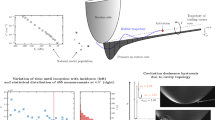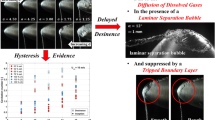Abstract
The spatial and acoustic characteristics of tip vortex cavitation (TVC) inception were measured in a cavitation tunnel. Numerous cavitation events were recorded to reveal the influence of different nuclei populations and cavitation numbers on nuclei capture and activation physics, and the role of the streamwise pressure distribution in a vortex. Synchronised high speed video and hydrophone measurements of cavitation events were taken in the trailing vortex of an elliptical hydrofoil at an incidence of \(6^\circ \) and a Reynolds number of \(1.5\times 10^6\). The injected nuclei population in the tunnel test section was varied by using different microbubble generators mounted upstream of the test section. Both the nuclei population and cavitation number have a significant effect on the inception location distribution along the trailing vortex, and in particular, inception event rates. The cavitation number alters the flow volume subjected to tension, thereby also affecting the shape of the inception location distribution. Once the nuclei are activated, cavity kinematic and acoustic properties are influenced by the local pressure (i.e. inception location and cavitation number) more so than initial nucleus size, at least in the \(\sim \)50–100 \(\upmu \hbox {m}\) diameter range considered in this study. Inception events that occur near the tip generate stronger acoustic pulses. At these inception locations, the frequency of the tonal peak associated with inception remains relatively constant for the two nuclei populations, but increases with cavitation number. This study provides insights into the roles of nucleation and cavitation number in TVC and informs future measurements and predictions of TVC dynamics and noise.
Graphic abstract


















Similar content being viewed by others
References
Arndt RE, Keller AP (1992) Water quality effects on cavitation inception in a trailing vortex. J Fluids Eng Trans ASME 114(3):430–438
Arndt R, Maines B (2000) Nucleation and bubble dynamics in vortical flows. J Fluids Eng Trans ASME 122(3):488–493
Asnaghi A, Svennberg U, Bensow RE (2020) Large eddy simulations of cavitating tip vortex flows. Ocean Eng 195:106703
Astolfi JA, Fruman D, Billard JY (1999) A model for tip vortex roll-up in the near field region of three-dimensional foils and the prediction of cavitation onset. Eur J Mech B Fluids 18(4):757–775
Brandner P, Lecoffre Y, Walker G (2007) Design considerations in the development of a modern cavitation tunnel. In: 16th Australasian fluid mechanics conference
Brennen CE (1995) Cavitation and bubble dynamics. Cambridge University Press, Cambridge
Briançon-Marjollet L, Merle L (1996) Inception, development and noise of a tip vortex cavitation. In: Proceedings of 21st symposium on naval hydrodynamics, pp 851–864
Chang N, Ganesh H, Yakushiji R, Ceccio SL (2011) Tip vortex cavitation suppression by active mass injection. J Fluids Eng 133(11):111301
Chen L, Zhang L, Peng X, Shao X (2019) Influence of water quality on the tip vortex cavitation inception. Phys Fluids 31(2):023303
Choi J, Ceccio SL (2007) Dynamics and noise emission of vortex cavitation bubbles. J Fluid Mech 575:1–26
Choi JK, Chahine GL (2003) A numerical study on the bubble noise and the tip vortex cavitation inception. J Ship Ocean Technol 7(3):13–33
Choi JK, Chahine GL (2004) Noise due to extreme bubble deformation near inception of tip vortex cavitation. Phys Fluids 16(7):2411–2418
Choi J, Hsiao CT, Chahine G, Ceccio S (2009) Growth, oscillation and collapse of vortex cavitation bubbles. J Fluid Mech 624:255–279
Doolan C, Brandner P, Butler D, Pearce B, Moreau D, Brooks L (2013) Hydroacoustic characterisation of the AMC cavitation tunnel. In: Acoustics 2013 Victor Harbor—Science, Technology and Amenity. The Australian Acoustical Society, Victor Harbor, Australia, pp 1–7
Ffowcs Williams J, Hawkings DL (1969) Sound generation by turbulence and surfaces in arbitrary motion. Philos Trans R Soc Lond Ser A Math Phys Sci 264:321–342
Fitzpatrick HM (1958) Cavitation noise. In: 2nd symposium on naval hydrodynamics, Washington
Franc JP, Michel JM (2006) Fundamentals of cavitation. Springer, Berlin
Fruman D, Dugue C (1994) Tip vortex roll-up and cavitation. In: Proceedings of 19th symposium on naval hydrodynamics, pp 633–654
Gindroz B, Billet M (1998) Influence of the nuclei on the cavitation inception for different types of cavitation on ship propellers. J Fluids Eng 120(1):171–178
Gindroz B, Billard JY, Geistdoerfer P (1995) Cavitation nuclei measurements at sea. ASME Publ HTD 321:497–504
Giosio D, Pearce B, Brandner P (2016) Influence of pressure on microbubble production rate in a confined turbulent jet. In: 20th Australasian fluid mechanics conference
Gowing S, Shen YT (2001) Nuclei effects on tip vortex cavitation scaling. In: 4th international symposium on cavitation, California
Higuchi H, Arndt R, Rogers M (1989) Characteristics of tip vortex cavitation noise. J Fluids Eng 111:495–501
Hsiao CT, Chahine GL (2005) Scaling of tip vortex cavitation inception noise with a bubble dynamics model accounting for nuclei size distribution. J Fluids Eng 127(1):55–65
Johnson BD (1986) Bubble populations: background and breaking waves. In: Oceanic whitecaps. Springer, pp 69–73. https://link.springer.com/book/10.1007/978-94-009-4668-2
Khoo M, Venning J, Pearce B, Brandner P (2018) Nucleation effects on hydrofoil tip vortex cavitation. In: 21st Australasian fluid mechanics conference
Khoo M, Venning J, Pearce B, Brandner P (2020a) Nucleation effects on tip vortex cavitation inception location. In: 22nd Australasian fluid mechanics conference. The University of Queensland
Khoo M, Venning J, Pearce B, Brandner P (2020b) Statistical aspects of tip vortex cavitation inception and desinence in a nuclei deplete flow. Exp Fluids 61(6):145
Khoo M, Venning J, Pearce B, Takahashi K, Mori T, Brandner P (2020c) Natural nuclei population dynamics in cavitation tunnels. Exp Fluids 61(2):34
Lamb H (1945) Hydrodynamics. Dover Publications, New York
Leighton T (2012) The acoustic bubble. Academic Press, New York
Ligneul P, Latorre R (1989) Study on the capture and noise of spherical nuclei in the presence of the tip vortex of hydrofoils and propellers. Acta Acust United Acust 68(1):1–14
Ligneul P, Latorre R (1993) Study of nuclei distribution and vortex diffusion influence on nuclei capture by a tip vortex and nuclei capture noise. J Fluids Eng 115(3):504–507
Maines B, Arndt R (1993) Bubble dynamics of cavitation inception in a wing tip vortex. In: ASME cavitation and multiphase flow forum, FED, 1993, vol 153, pp 93–97
Minnaert M (1933) XVI. On musical air-bubbles and the sounds of running water. Lond Edinb Dublin Philos Mag J Sci 16(104):235–248
Neppiras EA (1980) Acoustic cavitation. Phys Rep 61(3):159–251
O’Hern T, Green S, Morss E (1986) Measurements of oceanic nuclei distributions. In: ASME cavitation and multiphase flow forum, pp 23–26
Oweis G, van der Hout I, Iyer C, Tryggvason G, Ceccio S (2005) Capture and inception of bubbles near line vortices. Phys Fluids 17(2):022105
Paul R, Venning J, Pearce B, Brandner P (2021) Nuclei transport about a sphere. In: 11th international symposium on cavitation (CAV2021), Daejon, Korea
Peng X, Xu L, Cao Y (2017) The study of tip vortex flow and cavitation inception on an elliptical hydrofoil. In: Proceedings of fifth international symposium on marine propulsion, Espoo, Finland
Pennings P, Bosschers J, Westerweel J, Van Terwisga T (2015) Dynamics of isolated vortex cavitation. J Fluid Mech 778:288–313
Russell P, Giosio D, Venning J, Pearce B, Brandner P, Aumelas V, Maj G (2018) Towards real-time optical measurement of microbubble content in hydrodynamic test facilities. In: 10th international symposium on cavitation (CAV2018), Baltimore, Maryland, USA, pp 1056–1061
Russell P, Venning J, Pearce B, Brandner P (2020a) Calibration of Mie scattering imaging for microbubble measurement in hydrodynamic test facilities. Exp Fluids 61(4):93
Russell PS, Barbaca L, Venning JA, Pearce BW, Brandner PA (2020b) Measurement of nuclei seeding in hydrodynamic test facilities. Exp Fluids 61(3):79
Testa C, Ianniello S, Salvatore F (2018) A Ffowcs Williams and Hawkings formulation for hydroacoustic analysis of propeller sheet cavitation. J Sound Vib 413:421–441
Welch P (1967) The use of fast Fourier transform for the estimation of power spectra: a method based on time averaging over short, modified periodograms. IEEE Trans Audio Electroacoust 15(2):70–73
Acknowledgements
The authors acknowledge the support of the University of Tasmania and the Defence Science and Technology Group. The authors thank Dr Rhys Paul for assistance with data acquisition, and AMC technical officers, Mr Robert Wrigley and Mr Steven Kent for providing technical assistance with test facility configuration and operation.
Author information
Authors and Affiliations
Contributions
Conceived experiment design: MTK, JAV, PAB. Performed experiments: JAV, MTK. Analysed data: MTK, JAV. Prepared manuscript: MTK, JAV, PAB, BWP.
Corresponding author
Additional information
Publisher's Note
Springer Nature remains neutral with regard to jurisdictional claims in published maps and institutional affiliations.
Rights and permissions
About this article
Cite this article
Khoo, M.T., Venning, J.A., Pearce, B.W. et al. Nucleation and cavitation number effects on tip vortex cavitation dynamics and noise. Exp Fluids 62, 216 (2021). https://doi.org/10.1007/s00348-021-03308-2
Received:
Revised:
Accepted:
Published:
DOI: https://doi.org/10.1007/s00348-021-03308-2




